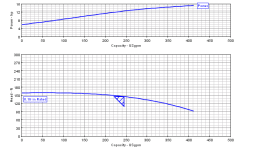To better understand the pressure/power confusion consider your vacuum cleaner with hose connected to 'blow'. When you plug the hose (deadheading it) the motor revs higher due to the reduced o'all load while maintaining output pressure. Open it again and you can hear rpm drop when moving more 'fluid'.
We also must remember that as water seeks it own level a deeper casing just allows more to enter, and at pressure for depth as draw down lowers that in the casing. Draw down will influence how deep pump should be, but pump 'sees' mostly head to tank and only needs to remain submerged during peak usage/draw down. Setting it unnecessarily lower won't increase output or pressure, and means moving a larger 'column' (volume/mass) going to tank. Example: FIL's 270' well, static level at ~30', 1 1/2 hp pump at 80', hydrant above wellhead ('before' tank) and with two 'chick-chick' sprinklers shooting 30'+ arcs you'd never know they were running when filling the washing machine. (time to fill nearly the same)
Goose and valveman, you well guys are way ahead of us non-pros (plumbing contractors here, btw) and we're all getting a much-appreciated lesson. I agree that while VFDs can have many benefits, use on small residential well pumps are tough to justify. On our shop machines they can do much for low hp motors with heavy starting loads and particular rpm needs, but otherwise are just a way to expand markets/applications for such bling. Saving energy with them makes sense as hp goes way up, but is surely pie in the sky at < a dozen hp. (IMO, whole-house tankless water heater efficency/convenience are also over-promoted for similar reasons, ie sales) Worth the $$ and complication? NOT.
It's easy to over-think such an installation, but easy to goof up too. I'd say anyone going from shallow well or jet pump to a submersible will be so tickled with the increased volume pressure they'll think they did everything right. If they fell short of goal (GPM/draw down) resetting a pump deeper shouldn't too big a chore.
btw, My shallow well pump/tank and WH stay well ahead of my eco showerheads, but using a hose outdoors is a joke. Looking forward to it's demise and going submersible as a step between that and 2" gas pump with 1 1/2" fire hose to water lawn etc.

